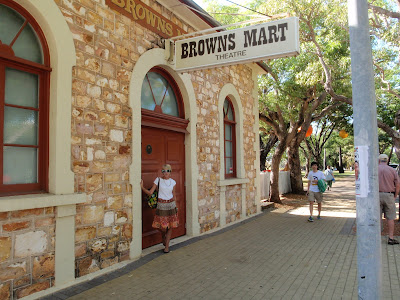 |
| A beautiful day of Spinnaker and Genoa sailing |
 |
| One of the many reef lighthouses, complete with helicpoter pad |
Our cruising lifestyle allows
us to stop and explore the places we visit for as little or long as we
want. We don't really have a schedule,
and mostly don't even have a plan. At
least one that actually matters. Our normal
cruising pattern is to day hop from island to island or bay to bay, staying
until it feels right to move on.
 |
| A great day with full sails |
 |
| Restoration Island. Capt Bligh landed here for rest after the mutiny |
 |
| A part of the navigation necessary through the Barrier Reef |
 |
| Another reef light. No helicopter pad for this one |
Getting to Darwin for the Indonesia Rally has been our goal for the
past month. Since leaving the Gold Coast
28 days ago, we covered 2100 nautical miles.
Some of this was ground we had already covered last year. It would have been nice to get back in to
Cruising Mode once we got north of Townsville but we were now mission oriented. Aviation has trained us well about the
insidious tendency of 'Get Home
Itis'. We refuse to be pushed by a
schedule into doing anything reckless.
Enough bad stuff already happens by itself.
 |
| A beautiful morning leaving Cape York |
Coastal Cruising is easier to
control than Blue Water passage making since you can choose the length of the
passages and you can usually find a nice place to hide from the elements when
things get tough. Since we left the Gold
Coast we have been Coastal Cruising doing 36 hours on and 12 hours off. A few times we went 60 on and 36 off. This let us do essentially a
"Redeye", then recover the following night, and then do it all again. That gave us a good 200+ mile range every two
days.
Fatigue is the biggest enemy
while coastal cruising. Falling asleep
on watch, missing a turn in the well marked but winding ship channel, would
have put us up hard on to one of the thousands of barrier reefs. That was a risk not worth taking and with a
two person crew, sleep is a precious commodity,
 |
| Crazy Seas in the Gulf of Carpentaria |
Bluewater passage making has
it's own dangers since you are exposed to the weather for the entire voyage and
there is nowhere to tuck in to sleep or get out of the elements. We had our share of that also for the 700
mile leg from Cape York to Darwin. The Gulf of Carpentaria is about 300 by 300 miles and is very shallow. When the wind gets blowing across the 300
miles of shallow sea, the waves get crazy.
 |
| The washing machine swell |
We had 2 good days of sailing from
Cape York with the wind behind us and fairly comfortable seas. Then the wind shifted from the south and we
were getting slammed by perpendicular 3 meter waves from behind and the side
with no option except to head north to New Guinea or just accept the beating. Tortuguita held up better than we did and the
following day we clawed our way toward the coast to reduce the amount of
distance that the waves could build.
 |
| The beach in front of our spot on Croker Island. |
That
tactic did work and even though we were still 50 miles from the coast, we were
able to get a few hours sleep that night compared to nothing the night
before. We really really needed sleep so
our goal was to find a place to anchor on the coast, or an offshore
island. The wind direction and strength
kept us from making the mainland but Croker Island was just what the doctor ordered. We dropped anchor at 4PM in a beautiful sandy bay and slept for over 10
hours. The next morning we awoke
refreshed and 24 hours later we were in Darwin.
 |
| The wharf at Seisia |
We saw some of the nicest areas
along our route north of Townsville and across the Arafura Sea but time didn't allow us to 'stop and smell the roses'. The unexplored and uninhabited areas of the
Inner Passage of the Great
Barrier Reef deserved at
least a few months.
Arnhem_Land, the northern section of the state of the Northern Territory, had some of the best coastline we have seen in Australia. It is an Aboriginal settlement area and permission is needed to visit, but would be well worth it to do that and spend a few months on that
coast also.
We keep justifying it by
saying that 'You can't see everything'.
Yes, but that doesn't quite do it.
That's how we ended up missing Vanuatu in the first place, and the winds won't take us back
this way once we leave.

























